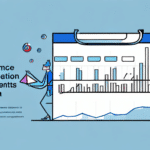Measuring Your Customer Retention KPI: A Guide to Success
As a business owner, understanding the metrics that drive your company's success is crucial. One of these key metrics is the Customer Retention Rate (CRR), which measures the percentage of customers who continue to do business with you over a specific period. In this comprehensive guide, we'll delve into customer retention, including calculating your CRR, understanding its importance, analyzing customer feedback, and implementing strategies to boost retention rates.
Understanding the Importance of Customer Retention
Customer retention is vital for businesses of all sizes and industries. Retaining existing customers is not only more cost-effective than acquiring new ones but also fosters loyalty, builds trust, and creates brand advocates. A high retention rate indicates that your customers find value in your offerings, are satisfied with your products or services, and trust your brand.
According to a Harvard Business Review study, increasing customer retention by just 5% can lead to an increase in profits of 25% to 95%. This underscores the significant impact that retention strategies can have on your bottom line.
Moreover, high customer retention enables you to establish a stable revenue stream and provides valuable insights into your customers’ needs and preferences, which can be used to enhance the customer experience, optimize marketing efforts, and attract new customers.
Calculating and Monitoring Customer Retention Rate (CRR)
How to Calculate CRR
The CRR is calculated by dividing the number of customers at the end of a period by the number of customers at the beginning of that period, subtracting any new customers acquired during the period, and then multiplying by 100 to get a percentage. The formula is:
- CRR (%) = [(E - N) / S] x 100
Where:
- E = Number of customers at the end of the period
- N = Number of new customers acquired during the period
- S = Number of customers at the start of the period
For example, if you started the year with 500 customers, acquired 100 new customers, and ended the year with 450 customers, your CRR would be 70% [(450 - 100) / 500 x 100].
Other Key Metrics for Retention
Beyond CRR, several other metrics provide a nuanced view of customer retention:
- Customer Lifetime Value (CLV): Estimates the total revenue a business can expect from a single customer account.
- Net Promoter Score (NPS): Measures customer loyalty and their likelihood to recommend your business to others.
- Churn Rate: The percentage of customers who stop using your product or service during a given time frame.
Tracking these metrics alongside CRR can help you gain a comprehensive understanding of your customer retention dynamics.
Strategies to Improve Customer Retention
Enhancing Customer Experience
Improving the overall customer experience is fundamental to retaining customers. This includes simplifying processes, addressing pain points, providing value-added services, and enhancing communication channels. For instance, implementing a seamless onboarding process can significantly reduce early churn rates.
Implementing Loyalty Programs
Loyalty programs incentivize repeat purchases and foster long-term relationships. Offering rewards, discounts, or exclusive access to new products can encourage customers to stay engaged with your brand. According to a study by Invesp, customers enrolled in loyalty programs generate 12-18% more revenue annually.
Personalization and Emotional Connections
Personalizing interactions by tailoring products, services, and communications to individual customer needs enhances loyalty. Using customer data to provide personalized recommendations or exclusive offers can create emotional connections that differentiate your brand from competitors.
Building emotional connections involves creating positive experiences that resonate on a personal level, fostering trust and loyalty. Brands like Amazon and Starbucks excel in this by leveraging data to personalize the customer journey.
The Role of Employee Engagement in Retention
Employees are pivotal in delivering exceptional customer service, which directly influences customer retention. Engaged employees who are motivated and aligned with your company's mission are more likely to provide better service, foster positive customer relationships, and contribute to a strong brand reputation. Investing in employee engagement initiatives, such as training programs, recognition systems, and fostering a positive work culture, can significantly impact your retention rates.
A Gallup report highlights that organizations with high employee engagement see a 21% increase in profitability and a 10% higher customer ratings compared to those with low engagement.
Avoiding Common Mistakes in Measuring CRR
Accurate measurement of CRR is essential for deriving actionable insights. Common pitfalls to avoid include:
- Inconsistent Definitions: Ensure that your definition of retention is consistent over time and across different departments to maintain data integrity.
- Short-Term Focus: Avoid focusing solely on short-term retention metrics without considering long-term customer value.
- Ignoring Customer Feedback: Failing to act on customer feedback can lead to missed opportunities for improvement and increased churn.
- Overlooking New Customer Acquisition: While retention is crucial, balancing it with efforts to acquire new customers is essential for sustained growth.
- Lack of a Coherent Strategy: Without a clear retention strategy aligned with business objectives, efforts may be fragmented and ineffective.
By addressing these common mistakes, businesses can ensure more accurate measurement and effective retention strategies.
The Future of Customer Retention
Customer retention strategies are evolving with advancements in technology and changing customer expectations. Key trends include:
- Personalization and AI: Leveraging artificial intelligence to deliver hyper-personalized experiences based on customer behavior and preferences.
- Omnichannel Experiences: Providing a seamless and integrated experience across all customer touchpoints and channels.
- Social Responsibility: Demonstrating ethical business practices and social responsibility to enhance customer loyalty and advocacy.
- Data Privacy and Security: Ensuring transparency and trust in the use of customer data to comply with regulations and build trust.
- Emerging Technologies: Utilizing technologies like blockchain and virtual reality to create innovative customer experiences.
Staying ahead of these trends can help businesses adapt their retention strategies to meet evolving customer needs and harness new opportunities.
Case Studies: Successful Companies with High CRRs
Examining successful companies provides valuable insights into effective retention strategies:
- Amazon Prime: Offers personalized recommendations, fast delivery, and exclusive content through its membership program, incentivizing repeat purchases and loyalty.
- Starbucks: Provides a consistent and personalized coffee experience, rewards frequent purchases through its loyalty program, and fosters community engagement via its mobile app.
- Zappos: Delivers exceptional customer service, a seamless shopping experience, and maintains a strong brand identity aligned with customer values.
These companies exemplify the power of customer-centricity, innovation, and emotional connections in driving high customer retention rates.
Leveraging Technology to Enhance Customer Experience
Technology plays a pivotal role in enhancing the customer experience and boosting retention rates. Key technological solutions include:
- CRM Software: Centralizes customer data, enabling personalized interactions and targeted marketing efforts.
- Chatbots and AI Assistants: Provide quick and efficient customer support, enhancing responsiveness and satisfaction.
- Personalization Engines: Analyze customer behavior to deliver relevant content and offers, increasing engagement.
- Data Analytics Tools: Enable real-time monitoring and optimization of retention metrics, facilitating data-driven decisions.
- Mobile Apps and Social Media: Offer seamless and engaging interactions, fostering continuous customer engagement.
While technology enhances efficiency and personalization, it's essential to maintain the human touch to build emotional connections and trust with customers.
Conclusion
Customer retention is a critical component of business success. By accurately measuring your CRR and other retention metrics, you gain valuable insights into customer behavior and needs. Understanding the importance of retention, calculating CRR, analyzing customer feedback, and implementing effective retention strategies can significantly increase loyalty, foster advocacy, and drive revenue growth.
Remember, customer retention is an ongoing process that requires continuous improvement and adaptation. Leveraging technology can enhance the customer experience, but maintaining a human-centric approach is essential for building lasting relationships. With these strategies and insights, your business can achieve sustained customer retention success.






















